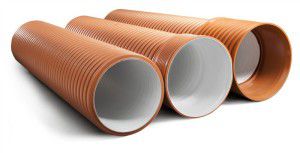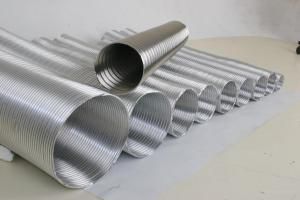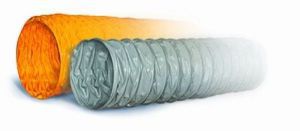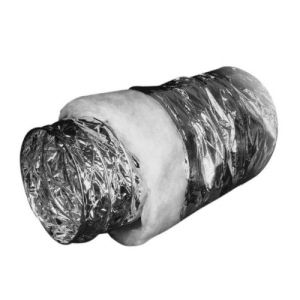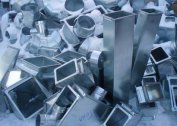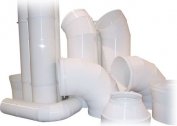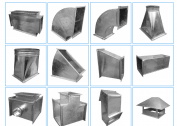Corrugated ventilation pipe is very widely used in modern construction. Convenience of installation, durability and low cost are attractive. But not in all cases the use of a corrugated pipe for ventilation is justified.
Types and applications of corrugated pipes for ventilation
Ventilation corrugated pipes are produced a little more than 20 years. Most often, corrugation pipes are used for ventilation systems of private houses, industrial shops, warehouses and elevators, mines.
Corrugated pipes for ventilation can be insulated or non-insulated. In addition, corrugated hoses for ventilation are divided by type of material:
- plastic (polyvinyl chloride);
- aluminum;
- steel;
- aluminum foil on the frame;
- polyester metallized tape on the frame.
The diameter of the ventilation corrugations is from 100 mm to 500 mm. They select it depending on the power of the equipment and the length of the ventilation ducts. Flexible corrugated tubes are often used for ventilation of complex configurations, with an abundance of transitions, elevations and turns. Moreover, they try to make straight sections from smooth air ducts, connecting them with corrugated hose sections for ventilation.
The elasticity of the corrugated pipe for ventilation allows you to use fewer building materials, create air ducts without sharp corners, which allows you to save pressure and air velocity. In order not to violate the integrity of the bearing walls and beams, a flexible corrugation for ventilation is simply pulled around them. Such installation is cheaper and takes less time.
Flexible elements are also convenient when connecting sections of ventilation ducts located at different levels. This is the optimal solution in small cramped spaces where stiff adapters do not fit.
Corrugated ventilation hoses have excellent aerodynamic properties. The pressure of the air flow passing through them decreases only slightly. Thus, the ventilation system works with the greatest return, rationally using electricity. The round cross-section of the corrugated hose for ventilation allows the use of fans of lower power. Directly in the ventilation ducts, it is possible to place devices for the redistribution of air flows, sensors and measuring instruments.
Passing through the ventilation corrugation with a diameter of 400 mm, the air emits less hum than when passing ventilation from the corrugation 200. Therefore, sections of corrugated ventilation hoses can be considered noise-canceling.
Aluminum and steel corrugated tubes
Steel and aluminum corrugated tubes for ventilation are classified as semi-rigid materials. Use them in cases where it is necessary to inexpensively, but qualitatively assemble the system. Corrugated pipes produce quite durable and lightweight ventilation structures.
Steel and aluminum corrugated ventilation ducts are similar in their properties and meet all technical standards:
- not combustible;
- easy to install;
- easy to replace and repair;
- corrugated hoses provide the ability to inspect ventilation.
Compared to other types of ducts, corrugated aluminum has a number of advantages:
- lungs;
- ventilation corrugated pipes do not accumulate static electricity;
- no need to ground;
- aluminum withstand temperature limits of -35 ... + 270 degrees Celsius;
- corrugated steel ventilation pipes are more heat-resistant and work up to +900 degrees Celsius;
- create airtight structures;
- stretch the duct is not necessary;
- not damaged by prolonged exposure to ultraviolet radiation;
- corrugated hoses for ventilation are not subject to corrosion;
- bend to a radius of -0.76.
And another advantage of steel and aluminum corrugated pipes for ventilation is a neat and pleasant appearance. Such corrugated ventilation ducts can not be covered with boxes in kitchens or in utility rooms.
Corrugated aluminum hoses for ventilation without loss of properties have been used for decades. Their installation is very simple: individual pieces are interconnected using metal tape. And the ability to stretch the original length by 3.5 to 4 times allows you to not purchase fittings.
However, aluminum ventilation corrugated tubes cannot be called a universal material.
In some cases, corrugated aluminum ducts cannot be used for ventilation:
- Since aluminum melts at high temperatures, it is forbidden to install a corrugation made of this material as a chimney for fireplaces, stoves and boilers on coal and wood. It is not advisable to install as a duct for a gas column, where the corrugation gradually burns out and creates the danger of poisoning people;
- Aluminum has a great temperature, so in the cold season it is a bridge of cold. The surface of the aluminum ventilation corrugated sleeve is covered with water droplets, increasing the humidity in the room. To prevent this negative effect, ventilation insulated corrugations are used.
For the convenience of mounting aluminum corrugated tubes, various accessories are produced:
- adapters from flexible to rigid pipes;
- adapters between flexible pipes;
- fuses against the entry of debris and dust into the pipes.
When assembling the ventilation system from aluminum corrugated pipes, they are guided by the general rules. Pieces of ventilation corrugation are joined by 400 couplings or bell-shaped joints. Couplings for thin steel pipes of suitable size can be used.
Steel couplings are used as follows:
- the end of the pipe is pulled over the end of the coupling;
- they put on 2 clamps (screw);
- the end of the joined pipe is pulled onto the other end of the coupling;
- the screws of the clamps are tightened and the joint is firmly pressed.
Since aluminum is very flexible, a properly made joint will be tight enough. It is easy to join two pipes with different diameters, inserting a thinner into a thick one by 0.5 m, and over tightening the structure with a clamp.
The use of aluminum corrugated ventilation hoses allows to reduce construction costs and carry out installation in a shorter time.
On sale there are aluminum ventilation corrugations of 100 mm, 200 and 400 mm. The minimum diameter is 80 mm, the maximum is 315 mm.
An aluminum ventilation corrugation is sold in pieces, the price depends on the diameter and length.
Aluminum corrugated pipe production
A ventilated aluminum corrugated pipe is made from aluminum foil supplied in rolls. The finished product has a circular cross section and a wall thickness of 0.06 - 0.12 mm.
The manufacturing process consists of several steps. Foil from a roll (strip) is fed to a rolling machine. Here, locks are pressed along the edges of the strip, and ribs in the middle of the sheet. Ribs give flexibility to the future pipe, the ability to shrink or stretch. The strip is wound on a profile with a diameter corresponding to the future pipe. The longitudinal edges of the strips are fastened with triple locks, passed through the rollers, which makes the pipe very strong. This is the structure of the elastic pipeline.
Plastic corrugated pipe
Plastic ventilation corrugations are made of polyvinyl chloride and are used to remove dust, gases, air, sawdust.Corrugated ducts are widely used for ventilation of enterprises of the chemical, furniture industry. The pipe can withstand temperatures from -20 to +65 degrees Celsius.
The material from which the plastic corrugation is made for ventilation is characterized by the following qualities:
- elasticity;
- strength;
- light weight;
- chemical neutrality;
- low flammability;
- resistance to moisture.
Resistance to aggressive media makes polypropylene pipes ideal for the ventilation of chemical plants and laboratories where organic or inorganic acid fumes fall into the air.
Plastic polyvinyl chloride corrugations for ventilation consist of a steel spiral, on top of which a layer of soft and flexible PVC is applied. The wall thickness is 1 millimeter. The thickness of the wire base is from 2 to 5 mm.
PVC ventilation corrugated pipe is produced with diameters from 15 to 30 cm, with coils of 10 - 50 m. 200 mm ventilation corrugation can be purchased both plastic and aluminum.
Due to the presence of a steel non-bending frame, the pipeline is not pinched.
A significant minus of the ventilation plastic corrugated pipes is the accumulation of static electricity.
Dust particles adhering to the inner surface of the channels gradually reduce the clearance and worsen the aerodynamic properties of the pipe.
Corrugated pipe made of polyester film and aluminum foil
Flexible ducts made of polyester film or aluminum foil are an improved analogue of corrugated pipes made of plastic. The wire frame with a pitch of 38 to 45 mm is wrapped in a polyester film with an aluminum coating or foil on a layer of polyester tape. For strength, up to 6 layers are wound, so ventilation from such corrugated hoses can withstand pressure up to 2400 Pa. Corrugated pipes made of polyester film are suitable for systems operating in the temperature range of -30 ... + 90 degrees Celsius. Foiled corrugated hoses for ventilation will withstand up to +130 degrees.
Corrugated hoses for ventilation from polyester tape and laminated foil are sold in pieces of 10 m. A variety of diameters allows you to choose a ventilation corrugation from 100 mm to 500 mm, including corrugation for ventilation 400 mm.
Thermally insulated corrugations for ventilation
A thin corrugated ventilation sleeve is cooled in the cold season, moisture from the warm air of the premises condenses on its walls. Therefore, the pipes must be insulated.
Gently insulate the corrugated pipe on its own is quite difficult.
Sometimes for this they build additional boxes filled with insulation. A bulky and not always appropriate design is created.
Ready-made insulated corrugations for ventilation immediately solve the condensate problem. The insulated corrugation is a multi-layer construction. The inner layer is a flexible duct made of polyester tape with aluminum coating. Next is mineral wool, wrapped in a protective layer of a metallized film. The thickness of the insulating layer is 2.5 cm. The frame of the ventilation corrugation under the insulation layer is made of high-carbon steel wire. To reduce flammability, an aqueous acrylic composition with flame arresters is used.
The purpose of the insulated ventilation corrugation:
- heat loss reduction;
- thermal insulation of ventilation systems;
- air conditioning ducts;
- prevention of condensation in ventilation ducts.
Ventilation corrugations with a layer of insulation are used in air exchange systems with a pressure of up to 2400 Pa, as peripheral lines for central air conditioners. And as exhaust pipes of ventilation systems of residential and industrial buildings.
On sale there are insulated ventilation corrugations of 200, 100, 300 and 400 mm.
The insulated corrugation is sold in segments of 10 m in cardboard boxes. Read more about installing an insulated corrugated pipe in our video.
Pros and cons of using corrugated tubes for ventilation
The use of corrugated hoses for ventilation gives a number of advantages compared to other materials:
- flexible and easy to bend;
- due to its elasticity it is possible to create the most complex structures of ventilation systems;
- strong enough;
- absorb noise;
- No need for connecting couplings, adapters and angles;
- easy to install;
- when folded, take up little space, facilitating transportation;
- Suitable for both indoor and outdoor use.
Corrugations for ventilation can be combined with square or rectangular channels. To connect them, adapters from round to square (rectangular) section are suitable.
The flexibility of the pipe makes it possible to assemble ventilation ducts of almost any shape. The one-piece elastic pipe bends easily by hand at any angle. Structures that are difficult to assemble from rigid pipes are easily mounted from corrugated pipes.
Disadvantages of ventilation corrugated pipes
- Corrugated ventilation tubes are less durable than rigid ventilation ducts. Therefore, they are mounted in such a way that there is easy access for replacement;
- The throughput of ventilation corrugated hoses is lower than that of smooth pipes. This is due to air turbulence formed during the passage between the grooves of the corrugation.

